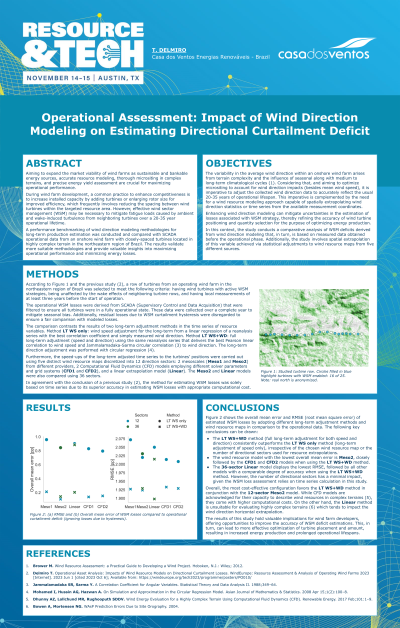Back

Wind: Operational Assessment
Operational Assessment: Impact of Wind Direction Modeling on Estimating Directional Curtailment Deficit
Tuesday, November 14, 2023
4:15pm – 5:15pm CST


Thales Delmiro
Wind Project Engineer
Casa dos Ventos Energias Renováveis
Fortaleza, Ceara, Brazil
Presenter(s)
Presentation Description: Aiming to expand the market viability of wind farms as sustainable and bankable energy sources, accurate resource modeling, thorough micrositing in complex terrains, and precise energy yield assessment are crucial for maximizing operational performance.
During wind farm development, a common practice to enhance competitiveness is to increase installed capacity by adding turbines or enlarging rotor size for improved efficiency, which frequently involves reducing the spacing between wind turbines within the targeted resource area. However, effective wind sector management (WSM) may be necessary to mitigate fatigue loads caused by ambient and wake-induced turbulence from neighboring turbines over a 20-35 year operational lifetime.
A performance benchmarking of wind direction modeling methodologies for long-term production estimation was conducted and compared with SCADA operational data from an onshore wind farm with closely-spaced turbines located in highly complex terrain in the northeastern region of Brazil. The results validate more suitable methodologies and provide valuable insights into maximizing operational performance and minimizing energy losses.
During wind farm development, a common practice to enhance competitiveness is to increase installed capacity by adding turbines or enlarging rotor size for improved efficiency, which frequently involves reducing the spacing between wind turbines within the targeted resource area. However, effective wind sector management (WSM) may be necessary to mitigate fatigue loads caused by ambient and wake-induced turbulence from neighboring turbines over a 20-35 year operational lifetime.
A performance benchmarking of wind direction modeling methodologies for long-term production estimation was conducted and compared with SCADA operational data from an onshore wind farm with closely-spaced turbines located in highly complex terrain in the northeastern region of Brazil. The results validate more suitable methodologies and provide valuable insights into maximizing operational performance and minimizing energy losses.
Learning Objectives:
- Upon completion, participant will be able to recognize the significance of suitable wind direction modeling in optimizing wind farm performance through a more accurate wind sector management strategy.
- Upon completion, participant will be able to explore the impact of suitable wind direction modeling on energy production estimation and operational efficiency by thorough micrositing in complex terrains.
- Upon completion, participant will be able to apply methodologies and best practices for incorporating Measured-Correlated-Predicted wind direction data.

